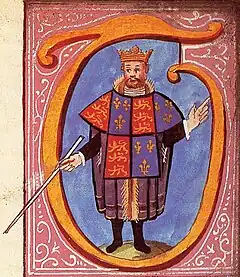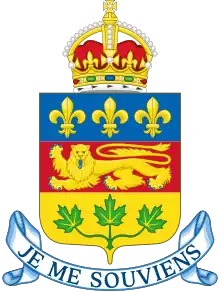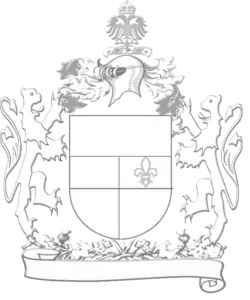Portal:Heraldry
Welcome to the Heraldry and Vexillology Portal!


Heraldry encompasses all of the duties of a herald, including the science and art of designing, displaying, describing and recording coats of arms and badges, as well as the formal ceremonies and laws that regulate the use and inheritance of arms. The origins of heraldry lie in the medieval need to distinguish participants in battles or jousts, whose faces were hidden by steel helmets.
Vexillology (from the Latin vexillum, a flag or banner) is the scholarly study of flags, including the creation and development of a body of knowledge about flags of all types, their forms and functions, and of scientific theories and principles based on that knowledge. Flags were originally used to assist military coordination on the battlefield, and have evolved into a general tool for signalling and identification, particularly identification of countries.
Selected coat of arms

The coat of arms of Albany, New York is a heraldic symbol representing the city of Albany, the capital of the U.S. state of New York. The coat of arms is rarely seen by itself; it is almost always used in the city seal or on the city flag. The current coat of arms was adopted in 1789, although prior to that it was significantly simpler, ranging from stylized lettering to a caricature of a beaver. Included in the coat of arms are references to Albany's agricultural and fur-trading past. It is supported by a white man and an American Indian and is crested by a sloop. The coat of arms is meant to represent the "symbols of industry and its rewards to man and beast on land and sea". (more...)
Selected article

Canadian heraldry refers to the cultural tradition and style of coats of arms and other heraldic achievements in modern and historic Canada, including national, provincial, and civic arms, noble and personal arms, ecclesiastical heraldry, heraldic displays as corporate logos, and Canadian heraldic descriptions.
Canadian heraldry derives mainly from heraldic traditions in France and the United Kingdom while adding distinctly Canadian symbols, especially those which reference the First Nations and other aboriginal peoples of Canada. Canadian heraldry has a unique system of cadency for daughters inheriting arms, and a special symbol for United Empire Loyalists. Since 1988, both personal and corporate heraldry in Canada is officially governed by the Canadian Heraldic Authority, which reviews all applications for arms. (more...)
Selected flag
.svg.png.webp)
The Flags of Puerto Rico represent and symbolize the island and people of Puerto Rico. The origins of the current flag of Puerto Rico, adopted by the Commonwealth of Puerto Rico in 1952, can be traced to 1868, when the first Puerto Rican flag, "The Revolutionary Flag of Lares", was conceived by Dr. Ramón Emeterio Betances and embroidered by Mariana "Brazos de Oro" Bracetti. The exiled Puerto Rican Revolutionary Committee chose the Flag of Lares as their standard. In 1892, the Revolutionary Committee adopted a design modeled after the Cuban flag. The new flag consisted of five equal horizontal bands of red (top and bottom) alternating with white; a blue isosceles triangle based on the hoist side bears a large, white, five-pointed star in the center.
The display of a Puerto Rican flag was outlawed and the only flags permitted to be flown in Puerto Rico were the Spanish flag (1492 to 1898) and the flag of the United States (1898 to 1952). In 1952, the Commonwealth of Puerto Rico declared the flag originally designed in 1892 to be the official flag, but without specifying the tones of colors to be used. The color of the triangle that was used by the administration of Luis Muñoz Marín was the dark blue that is used in the flag of the United States, instead of the original light blue, thus creating a political controversy which has lasted throughout the years. (more...)
Selected picture

The coat of arms of Albrecht Dürer are canting arms, and a well known example of German burgher arms.
Did you know...
.svg.png.webp)
- ...that Atlanta, Georgia-based architect Cecil Alexander designed a controversial Georgia state flag (pictured) that flew from 2001-2003?
- ...that Themba Mabaso, the State Herald of South Africa (pictured), also wrote a children's book?
- ...that the Seal of the Federal Bureau of Investigation was first used on January 1, 1941 and represents the values, standards and history of the FBI and its agents?
- ...that according to Chinese scholar Wei Yuan, British ships mistook Chinese red flags for a declaration of war, triggering the First Battle of Chuenpee (1839) in the First Opium War?
- ...that educator Anna Essinger, ordered to fly the swastika on Hitler's birthday in 1933, planned a day-long outing for her school, leaving the flag to fly over an empty building?
Related portals
Major topics and navigation
|
Heraldry Heraldry by country Heraldic artists Heraldists Officers of arms Heraldic authorities Heraldic badges Coats of arms Ecclesiastical heraldry Heraldic elements External devices in achievements Flags by design Headgear in heraldry Heraldic sites Heraldry and law Literature on heraldry Military heraldry Offices of arms Orders, decorations, and medals Rolls of arms Seals (insignia) Heraldic societies Heraldic tinctures Totem poles Vexillology Heraldry stubs Vexillology Flag days Flag flying days Flagpoles History of flags Literature on vexillology Vexillological organizations Vexillologists |
Flags Flags by subject Lists and galleries of flags Flags by continent Flags by country Flags by design Flags by year of introduction Types of flags Flag anthems Flag controversies Flag designers Flags adopted through competition Historical flags History of flags Flag manufacturers Flag practices Proposed flags Representations of flags Vexillography Vexillology Flag images Flag stubs
|
Heraldry Web resources
Authorities
- Belgium - The Council of Nobility, Flemish Heraldic Council and Council of Heraldry and Vexillology of the French Community
- Canada - Canadian Heraldic Authority and see also Public Register of Arms, Flags and Badges
- England, Wales, and Northern Ireland - The College of Arms
- Ireland - The Office of the Chief Herald of Ireland
- Netherlands - High Council of Nobility
- Portugal - Instituto da Nobreza Portuguesa
- Scotland - The Court of the Lord Lyon
- South Africa - South African Bureau of Heraldry
- Sweden - National Board of Heraldry, The National Archive
- United States Army - The United States Army Institute of Heraldry
Societies
- Greek Heraldry Society
- The Academy of Heraldic Science Czech republic
- The American College of Heraldry
- The American Heraldry Society
- The Augustan Society
- The Australian Heraldry Society Inc.
- Bulgarian Heraldry and Vexillology Society
- The Center for Research of Orthodox Monarchism
- Cambridge University Heraldic and Genealogical Society
- Chiltern Heraldry Group
- The College of Dracology
- Croatian Heraldic and Vexillologic Association
- The Finnish Heraldic Society
- Fryske Rie foar Heraldyk
- Hellenic Armigers Society
- Guild of Heraldic Artists
- Genealogical Society of Ireland
- Heraldry Research Institute (Japan)
- The Heraldry Society
- The Heraldry Society of Africa
- The Heraldry Society of New Zealand Inc.
- The Heraldry Society of Scotland
- The Heraldry Society of Southern Africa
- The Institute of Heraldic and Genealogical Studies
- The International Association of Amateur Heralds
- Italian Center of Vexillological Studies
- Lancashire Heraldry Group
- Macedonian Heraldry Society
- New England Historic Genealogical Society Committee on Heraldry
- Norwegian Heraldry Society
- Oxford University Heraldry Society
- Polish Heraldry Society
- Polish Nobility Confederation
- Real Academia Matritense de Heráldica y Genealogía - Royal Academy of Heraldry and Genealogy of Madrid
- Romanian Institute for Genealogy and Heraldry
- The Royal Heraldry Society of Canada
- The Russian College of HeraldryThe Russian College of Heraldry
- Serbian Heraldic Society
- Societas Heraldica Scandinavica
- Societas Heraldica Slovenica
- Swedish Heraldic Society
- Ukrainian Heraldry Society
- Royal Association Genealogical and Heraldic Office of Belgium
Vexillology
Software
- Coat of Arms Visual Designer web-based program
- Puncher Heraldry Program
- Blazonry Server - pyBlazon
- DrawShield - creates SVG shield or arms image from blazon
- CoaMaker - web-based tool
- Blazon95 and BLAZONS! 2000, older Windows applications
Texts
Other
Wikimedia
The following Wikimedia Foundation sister projects provide more on this subject:
-
 Commons
Commons
Free media repository -
 Wikibooks
Wikibooks
Free textbooks and manuals -
 Wikidata
Wikidata
Free knowledge base -
 Wikinews
Wikinews
Free-content news -
 Wikiquote
Wikiquote
Collection of quotations -
 Wikisource
Wikisource
Free-content library -
 Wikispecies
Wikispecies
Directory of species -
 Wikiversity
Wikiversity
Free learning tools -
 Wikivoyage
Wikivoyage
Free travel guide -
 Wiktionary
Wiktionary
Dictionary and thesaurus

